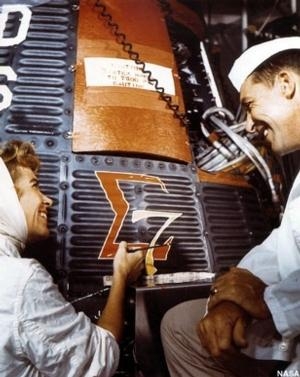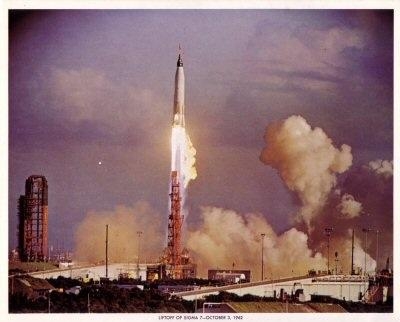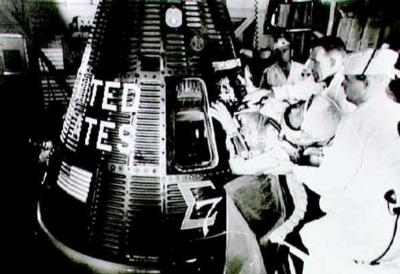First Flight To Go Beyond Three Orbits Presented Unique Challenges
By Wes Oleszewski
Often in spaceflight documentaries it is portrayed that Wally Schirra’s Project Mercury flight, Sigma 7, took place during the Cuban Missile Crisis of October 1962. Statements such as “Wally blasted off into the heart of the Cuban Missile Crisis” or “unlike the other Mercury flights, Wally splashed down in the Pacific otherwise he’d have landed smack in the middle of the Cuban Missile Crisis” and “His flight(was barely noticed) because the American public was riveted to the Cuban Missile Crisis” are often scripted into modern accounts of Project Mercury. This is proof that the production companies who make such TV documentaries have lots of money for hiring producers, assistant producers, assistant to assistant producers, but never spend a dime on research historians to fact-check their scripts. The fact is, the American public, the Kennedy Administration, the Department of Defense and even the CIA were unaware of a Cuban Missile Crisis at the time of
Schirra’s flight- because the was no Cuban Missile Crisis at the time. The events of the Cuban Missile Crisis would not even begin for another two weeks.

Sigma 7 was the first Mercury flight to be extended beyond the Project Mercury’s original design planning of three orbits. This brought into play several problems, the greatest of which was the earth rotating on its axis. During a three orbit flight, such as that of John Glenn and Scott Carpenter, the earth rotated about 67.5 degrees underneath the plane into which the spacecraft has been inserted. Thus, NASA had placed all of its ground tracking and communication assets within range for such flights. On Schirra’s six orbit flight, however, the earth would rotate a total of 135 degrees under Sigma 7. That meant that Schirra’s spacecraft would work its way farther and farther south and would be out of range of more and more of the established stations on orbits four, five and six. Additionally, a retro-fire in orbit six would splash Sigma 7 down in the Pacific rather than the Atlantic. So, Schirra’s landing in the Pacific Ocean had nothing to do with the Soviet Union or Cuba- it
had everything to do with the earth’s axis.
Another problem that had to be solved was the fuel consumption issue that had bitten Scott Carpenter, who ran out of reaction control fuel during his reentry. Part of the blame can be attributed to human error and poor pre-flight management and work-load planning, but the majority of the blame was in system design. A Mercury spacecraft had two reaction control system (RCS) settings; automatic also know as “Fly-By-Wire” (ASCS) control system and the manual system. Acting proportionally to the astronaut’s control handle movements the RCS system fired two sets of thrusters; a 1 pound thrust series of thrusters and a 24 pound thrust series. On vehicles previous to Sigma 7 it was possible to not only fire RCS in the ASCS mode, but also in manual mode simultaneously- thus the pilot could gain “double authority” on the RCS if needed. The problem was two-fold in that the double authority configuration could be inadvertently used, as happened with Carpenter’s flight, and
there was also no way to isolate the 24 pound high-thrust jets- which were fuel guzzlers. In Sigma 7 the astronaut was given a switch to isolate the 24 pound thrust jets and given “extra training” to prevent from accidentally entering the double authority mode. For most of his flight Schirra used only the 1 pound thrusters in an RCS firing method known as “ASCS Low” that he liked to call “mouse fart.”

On the morning of October 3rd, 1962 at 07:15:11 am, Mercury Atlas 113D lifted off from Cape Canaveral. Sigma 7 with Wally Schirra on board was lofted into a 176 by 100 statute mile orbit that took him around the earth once every 88.9 minutes. Although Schirra did have a few “scientific experiments” to do during his mission, he was not completely overloaded as had been the case with Scott Carpenter. Schirra was tasked instead with actually test flying the equipment. The first major portion of that task was working with his space suit’s environmental control. In Carpenter’s flight the suit controls and down-linked telemetry tended not to agree while the suit temperature fluctuated to a great degree. Working the problem soon became a major distraction. In the Mercury program itself, the job of working suit development had been Schirra’s, so now the right man for the job was in the cockpit. He found that simply by making very small adjustments and allowing the suit’s
system time to catch up, there was no problem at all.
Sigma 7’s second orbit found Schirra working to see how well he could adjust the spacecraft’s alignment and attitude without the use of his instruments- the primary concern being in the yaw axis. In the first test, Schirra covered his attitude indicator and went into the retro-fire attitude using features seen through the spacecraft window. He then yawed 8 to 10 degrees away and attempted to get back to the initial attitude. He later repeated the exercise by yawing 23 degrees out and returning. Each time he came to within 2 degrees of his starting point.
On his third orbit Schirra was asked to try the “eating test” and he also went ahead on his own to conduct the “Voas test.” This test was named for Dr. Robert Voas who had worked extensively in forming the aero-medical training for the Mercury astronauts. His test consisted simply of having the pilot close his eyes and reach out for known objects in the cockpit and thereby see if there was any disorientation in zero gravity. Many involved in the Mercury program objected loudly to this test. They were in fear that the astronaut may hit a switch or lever and accidentally abort the mission- or worse. By the time of Sigma 7, however, the timid managers had been quieted to the point where the test was allowed. Schirra reached out and with his eyes closed touched the manual lever, the clock, some rivets above the clock, the yaw indicator and his emergency rate lever without any disorientation- and without any disaster. He spent the rest of that orbit flying attitudes and sighting
stars.

As Sigma 7 entered its fourth orbit the earth below it was slipping farther north. NASA had pre-positioned tracking ships in the southern Pacific to alleviate the communication and tracking gaps. Stationed near Midway Island were the Huntsville, American Mariner and Watertown. Additionally the Atlantic relay ship was refitted with command capability and stationed south of Japan and the Quito, Ecuador tracking station was activated.
Schirra spend orbits 4, 5 and what remained of 6, powering systems on and off to see how they acted when exercised. He also took photos and practiced additional star sighting and vehicle orientation. His was a text book example of a test pilot taking her up, ringin’ her out and bringin’ her back- exactly the sort of mission Wally Schirra loved to fly.
He fired Sigma 7’s retros at exactly the correct moment and after reentry was so close to his landing target that the crew of his recovery ship, the USS KEARSARGE, saw his capsule’s contrail in the sky and heard its sonic booms. Sigma 7 landed with 60% of its manual fuel remaining and 50% of its automatic fuel- an amazing demonstration of precision flying.

Wally Schirra (pictured) went on to command Gemini 6 and fly the first rendezvous in space by flying in formation with Gemini 7. He later went on to command the first flight of an Apollo spacecraft, Apollo 7, just six years after his Mercury flight. Schirra was the only man to fly Mercury, Gemini and Apollo spacecraft. He retired from NASA after the Apollo 7 mission, but remained a favorite of almost everyone who was involved in, or a follower of spaceflight. He passed away on May 3rd, 2007.
(All images courtesy NASA)
 ANN's Daily Aero-Term (04.20.24): Light Gun
ANN's Daily Aero-Term (04.20.24): Light Gun Aero-News: Quote of the Day (04.20.24)
Aero-News: Quote of the Day (04.20.24) ANN's Daily Aero-Linx (04.21.24)
ANN's Daily Aero-Linx (04.21.24) Aero-News: Quote of the Day (04.21.24)
Aero-News: Quote of the Day (04.21.24) ANN's Daily Aero-Term (04.21.24): Aircraft Conflict
ANN's Daily Aero-Term (04.21.24): Aircraft Conflict






